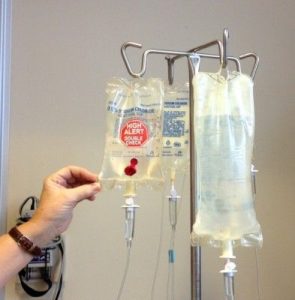Movement disorders, different types are difficult to distinguish

Movement disorders and the difficulty in distinguishing the different types
What actually are movement disorders? Many laymen will not be able to make themselves at the first moment a right picture, which can be understood under this complex at neurological illnesses.
Some may think of an unrounded gait, limping or dragging of the leg, possibly uncontrolled rashes of arms and feet, trembling of the hands, or even cramping and involuntary twitching.
But the correct diagnosis is elementary in the treatment of movement disorders, which is why the self-help association Dystonia-and-Du e.V. currently draws attention to the problems in the correct anamnesis, examination, findings and assessment of movement abnormalities and would therefore like to encourage people to consider the differences between the individual clinical pictures and to seek outpatient or inpatient help especially where one specializes in diseases of the musculoskeletal system.
“Often these are university hospitals with specially set up special outpatient clinics or neurologists in private practice with their own focus,” explains Ulrike Halsch, chairwoman of the association.
But also for the non-medical profession movement disturbances can be separated and classified on the basis important core characteristics quite simply from each other. So explains the psychosocial consultant of dystonia-and-you e.V., Dennis Riehle, who is himself affected and is also certified in basic medicine:
Dystonia
As a disease of the extrapyramidal system of the motor brain, this disorder is a hyperkinetic disorder with the leading symptomatology of muscle cramps or incorrect posture.
Often parts of the body appear twisted or tilted due to spasms, causing constant tension with pain and contractions of various muscle groups of the body.
Examples are cervical dystonia or “torticollis”, a malposition of the head, but also oromandibular and spasmodic dystonia with cramping and displacement of the mouth and chewing apparatus, respectively a cramping of the vocal cords.
In addition, limb dystonia is also common, which can manifest itself as writer’s cramp, foot dystonia and musician’s cramp, and involves malposition of the hands, arms and legs.
Blepharospasm is a spasm of the eyelids that causes uncontrolled blinking.
Parkinson’s disease
The disorder formerly known as “shaking palsy” is the most prominent movement disorder, which in most cases is associated with symptoms of tremor, muscle stiffness, and psychomotor slowing.
Early warning signs include a possible change in sense of smell and taste, depressive moods and sleep disturbances.
As the condition progresses, problems with coordination, upright gait and posture, balance problems, decreased facial expressions, continence problems, small-step problems, blood pressure problems, dementia-like difficulties, and hallucinations become more frequent.
Only when several of these symptoms occur can doctors make a definite diagnosis. Because Parkinson’s is often confused with simple tremor disorders.
Chorea disease and ballismus
In this case, short, repetitive, sudden movements of different parts of the body can turn into a chronic and persistent movement disorder, which mainly affects the face, mouth, trunk and limbs and is mostly recurrent and persistent.
Ballism as a paralysis symptom, which is released again by an abrupt and rash body reaction and thus suppresses round and regular movement sequences, occurs predominantly as a hemiplegic manifestation.
Tremor
Different forms of tremor are summarized here. A distinction is made here between resting and action tremor, ultimately the question of whether the uncontrolled movement occurs only at rest or during controlled action sequences.
Similarly, differentiation can be made according to the intention to move, for example, intention tremor (occurring during a movement action directed towards a goal), kinetic tremor (occurring at the completion of a course of action) or postural tremor (tremor when extending and holding a limb).
Causative can be separated from: Physiologic (naturally occurring tremor), essential (congenital, genetic tremor), cerebellar (originating in the brain), or secondary tremor (tremor triggered by medications or other conditions).
Often an exaggerated tremor in stressful situations is completely normal.
Myoclonia
In contrast to dystonia, there are only short, involuntary and rapidly self-restoring twitches of muscle groups and individual joints.
In contrast to other movement disorders, the cause of this disease is mainly to be found in the side effects of medications such as antiepileptic drugs or tranquilizers, in liver or kidney damage, head injuries or infectious clinical pictures.
Especially in metabolic diseases, myoclonia of the face, thigh or upper arm can occur and are remitting by the removal of the trigger. Triggers for myoclonic disorder may include light and sound.
Functional movement disorders
These are movement disorders that are based on a psychogenic cause and for which, in the first instance, no physically measurable origin can be determined.
In principle, every movement disease is also functionally possible. Although rare, psychogenic Parkinson’s disease, functional dystonia or emotional tremor are serious disorders that can only be diagnosed after all possibilities of a physical cause have been ruled out by differential diagnostics.
Diagnosis for all movement disorders should first include imaging of the head and blood sampling. This makes it quite easy to rule out internal diseases as the cause in particular.
An MRI scan of the skull can easily identify possible injuries or hemorrhages as well as a mass and exclude them as the origin of the movement disorder.
In addition, the neurological-clinical examination should first determine whether a recognizably hyperkinetic (movement-rich) or hypokinetic (movement-poor) disorder is present.
Since most neurological diseases of the musculoskeletal system usually find their organic cause in the basal ganglia, a supplementary nuclear medical examination may be necessary.
Here, the metabolic activity in the corresponding area of the brain is determined by means of a so-called “PET-CT”.
In addition, a “DaTSCAN” can be used to determine whether there is reduced or excess dopamine production in the head – because too little dopamine indicates Parkinson’s disease, while too much dopamine indicates hyperkinetic disorders.
Ultimately, the question remains whether medication can also be causative for the movement disorder.
An experienced physician will therefore take a thorough medical history in order to clarify whether a parkinsonism (a drug-induced Parkinson’s syndrome) may be present.
Functional movement disorders are difficult to differentiate, as a psychological cause should not be assumed lightly.
Indications of a psychogenic event are fluctuating symptoms (rapidly changing symptoms that vary greatly in severity on different days or hours), sudden onset or abatement of limitations, no response to drug therapy, laboratory and neuroradiological findings that are unremarkable, and a suspected traumatic stressful life situation in the past or present that leads to dissociative behavior – i.e., shows tendencies to reject certain body parts or personality traits.
Therapeutically, the individual movement disorders are approached differently
While Parkinson’s is classically treated with dopamine administration and accompanied by physical, ergo and psychotherapeutic measures, in dystonia anticholinergics and muscle relaxants, rarely also sedative psychotropic drugs, botulinum toxin and in isolated cases deep brain stimulation are the means of choice.
Physiotherapeutic measures and psychological support are also considered. In the case of tremor, an attempt is made to find the cause and treat it accordingly.
In some cases, beta-blockers, anticonvulsants and antidepressants can bring relief. In severe cases, deep brain stimulation can also be considered. The same treatment options are also conceivable for myoclonia.
In the case of chorea and ballismus, special attention should be paid to possible metabolic diseases, kidney or liver problems as the origin of the disease, and these should be treated as a priority.
Here, too, antiepileptic drugs and some antipsychotics can bring relief from the actual movement disorder.
However, implantation procedures on the brain are only very rarely considered here. Instead, medications from the medical history that can cause a movement disorder as a side effect should be replaced by equivalent preparations.
Functional movement disorders can be approached with psychodynamic or trauma therapeutic measures. Intensive psychosocial support is needed.
In individual cases, mild antidepressants can be used for accompanying support.
In all movement disorders, it is worthwhile to make use of selected relaxation methods, massages, speech and logopedagogical concepts, cognitive exercises as well as an adequate supply of vital substances.
As Ulrike Halsch and Dennis Riehle explain in conclusion, the association offers an exchange of experiences and information to affected persons and relatives, but also to patients with an unclear diagnosis of a possible movement disorder.
In addition, the association has set up a psychosocial mail counseling and thus provides low-threshold support to all those seeking help free of charge. You can contact directly: Dennis.Riehle(at)dysd.de.
Further information can be found on the homepage www.dystonia-and-you.de be called up.
About the background: Dystonia describes a variety of disorders in which involuntary muscle contractions are expressed in spasms and can lead to painful and uncontrollable contractions and extensions of various joints (especially the wrists and finger joints), the eye muscles, the voice, the facial muscles, the masticatory apparatus or the neck muscles.




